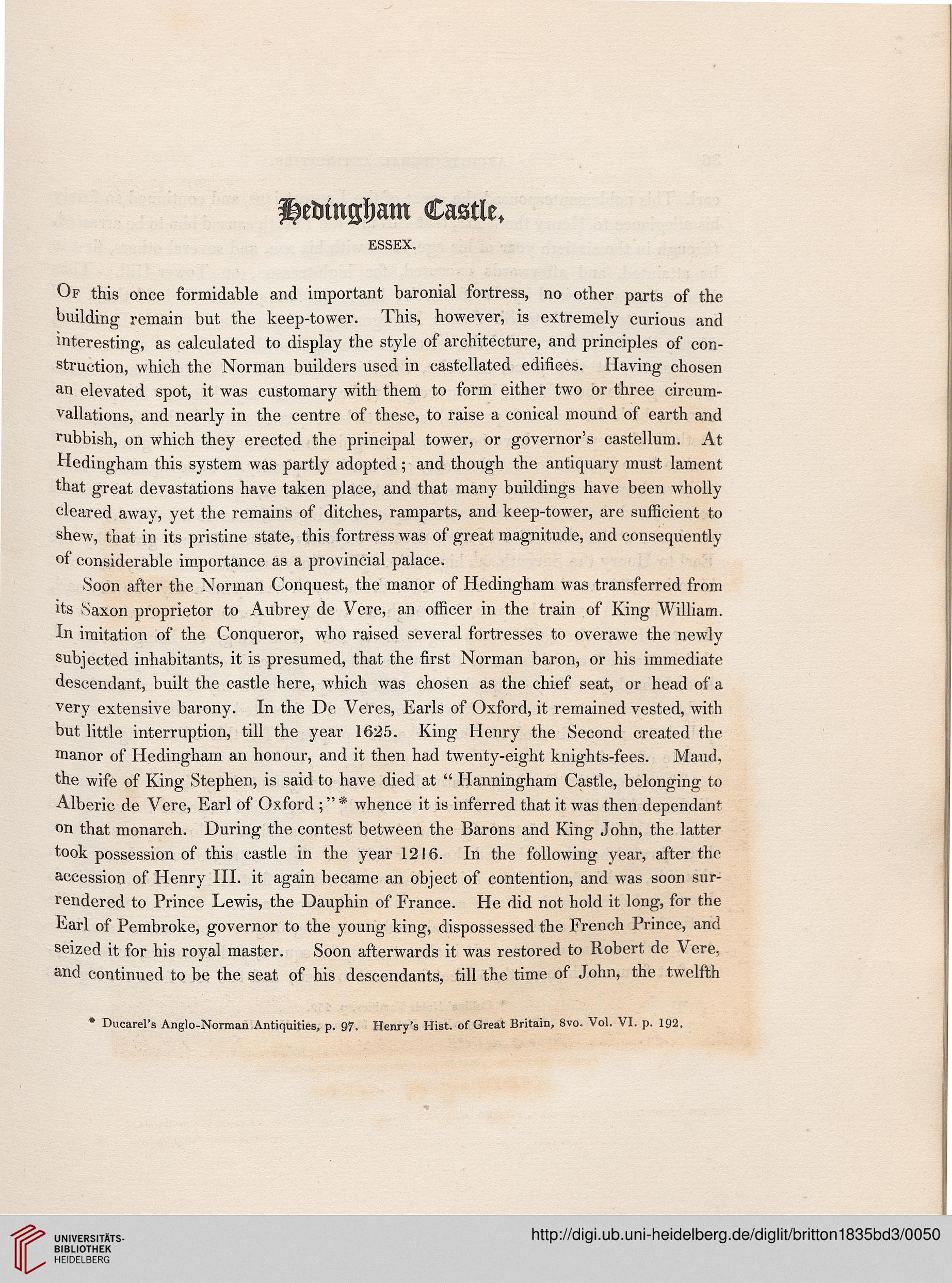f^e&mgjwm Castle,
essex.
Of this once formidable and important baronial fortress, no other parts of the
building remain but the keep-tower. This, however, is extremely curious and
interesting, as calculated to display the style of architecture, and principles of con-
struction, which the Norman builders used in castellated edifices. Having chosen
an elevated spot, it was customary with them to form either two or three circum-
vallations, and nearly in the centre of these, to raise a conical mound of earth and
rubbish, on which they erected the principal tower, or governor's castellum. At
Hedingham this system was partly adopted; and though the antiquary must lament
that great devastations have taken place, and that many buildings have been wholly
cleared away, yet the remains of ditches, ramparts, and keep-tower, are sufficient to
shew, that in its pristine state, this fortress was of great magnitude, and consequently
of considerable importance as a provincial palace.
Soon after the Norman Conquest, the manor of Hedingham was transferred from
its Saxon proprietor to Aubrey de Vere, an officer in the train of King William.
In imitation of the Conqueror, who raised several fortresses to overawe the newly
subjected inhabitants, it is presumed, that the first Norman baron, or his immediate
descendant, built the castle here, which was chosen as the chief seat, or head of a
very extensive barony. In the De Veres, Earls of Oxford, it remained vested, with
but little interruption, till the year 1625. King Henry the Second created the
manor of Hedingham an honour, and it then had twenty-eight knights-fees. Maud,
the wife of King Stephen, is said to have died at " Hanningham Castle, belonging to
Alberic de Vere, Earl of Oxford ;" * whence it is inferred that it was then dependant
on that monarch. During the contest between the Barons and King John, the latter
took possession of this castle in the year 1216. In the following year, after the
accession of Henry III. it again became an object of contention, and was soon sur-
rendered to Prince Lewis, the Dauphin of France. He did not hold it long, for the
Earl of Pembroke, governor to the young king, dispossessed the French Prince, and
seized it for his royal master. Soon afterwards it was restored to Robert de Vere,
and continued to be the seat of his descendants, till the time of John, the twelfth
• Ducarel's Anglo-Norman Antiquities, p. 97. Henry's Hist, of Great Britain, 8vo. Vol. VI. p. 192.
essex.
Of this once formidable and important baronial fortress, no other parts of the
building remain but the keep-tower. This, however, is extremely curious and
interesting, as calculated to display the style of architecture, and principles of con-
struction, which the Norman builders used in castellated edifices. Having chosen
an elevated spot, it was customary with them to form either two or three circum-
vallations, and nearly in the centre of these, to raise a conical mound of earth and
rubbish, on which they erected the principal tower, or governor's castellum. At
Hedingham this system was partly adopted; and though the antiquary must lament
that great devastations have taken place, and that many buildings have been wholly
cleared away, yet the remains of ditches, ramparts, and keep-tower, are sufficient to
shew, that in its pristine state, this fortress was of great magnitude, and consequently
of considerable importance as a provincial palace.
Soon after the Norman Conquest, the manor of Hedingham was transferred from
its Saxon proprietor to Aubrey de Vere, an officer in the train of King William.
In imitation of the Conqueror, who raised several fortresses to overawe the newly
subjected inhabitants, it is presumed, that the first Norman baron, or his immediate
descendant, built the castle here, which was chosen as the chief seat, or head of a
very extensive barony. In the De Veres, Earls of Oxford, it remained vested, with
but little interruption, till the year 1625. King Henry the Second created the
manor of Hedingham an honour, and it then had twenty-eight knights-fees. Maud,
the wife of King Stephen, is said to have died at " Hanningham Castle, belonging to
Alberic de Vere, Earl of Oxford ;" * whence it is inferred that it was then dependant
on that monarch. During the contest between the Barons and King John, the latter
took possession of this castle in the year 1216. In the following year, after the
accession of Henry III. it again became an object of contention, and was soon sur-
rendered to Prince Lewis, the Dauphin of France. He did not hold it long, for the
Earl of Pembroke, governor to the young king, dispossessed the French Prince, and
seized it for his royal master. Soon afterwards it was restored to Robert de Vere,
and continued to be the seat of his descendants, till the time of John, the twelfth
• Ducarel's Anglo-Norman Antiquities, p. 97. Henry's Hist, of Great Britain, 8vo. Vol. VI. p. 192.




